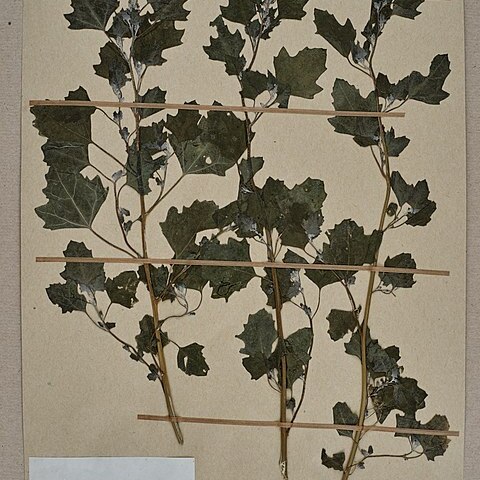Erect, branched annual 0.5-3 m tall, farinose, at least when young and on lower surface of lvs, non-aromatic. Petiole 1-2× lamina, slender; lamina on flowering branches to 3 × 2 cm, broad-ovate, rhombic-ovate, slightly 3-lobed at base, green above, grey-farinose below, irregularly serrate-dentate; base ± cuneate; apex often obtuse; upper lvs narrower, entire. Infls narrow-paniculate, terminal and axillary, grey-farinose, leafless in uppermost part; glomerules small, c. 3 mm diam., very numerous and densely arranged. Perianth segments 0.5-1 mm long at anthesis, accrescent, somewhat imbricate; keel ± obtuse, green; margin broadly hyaline. Fr. almost completely invested by perianth; pericarp easily removed. Seed horizontal, 1.1-1.3 mm diam., circular, flattened; margin obtuse; testa glossy black, with rather faint longitudinal striations.
Annual herb (short-lived perennial, with stems becoming woody below, closely related to C. album), 0.3-1.5 m high, erect, much branched, green, ± clothed with grey-mealy hairs. Leaves variable, 7-54 x 4-54 mm, margins with up to 10 shallow teeth or lobes on each side, lowermost lobes more prominent, divergent, base concave, apex rounded to acute. Inflorescences ample panicles of many small, dense, rounded clusters, with minute grey to greenish flowers. Perianth: segments 5, papillose with grey-mealy hairs on margins and outside. Pericarp persistent, readily scraped from seeds. Seeds black, shining.
Leaves variable, mostly broadly and shortly rhombic-ovate, the median and lower almost as broad as long, c. 0.7–5.4 × 0.4–5.4 cm., leaf margins usually with up to about 10 mostly shallow teeth or lobes on each side, often the lowermost teeth or lobes more prominent divergent and often bilobed; sometimes margins entire or nearly so and leaves elliptic especially (it seems) if plants perennate; apex of leaf rounded to acute.
Annual herb (or ? sometimes a short-lived perennial with stems becoming woody below), closely related to C. album, up to 0.6–1.5 (3) m. high, erect, normally much branched, green to almost white, rarely red-tinged, more or less clothed with mealy vesicular hairs, sometimes densely so on young shoots inflorescences and undersides of leaves.
Pericarp somewhat persistent, but readily scraped off seed. Seeds black, shining, subcircular, 1.0–1.5 mm. in diam. bluntly keeled; testa (seen under microscope) marked with numerous spaced radial furrows and minute papillose roughening in between.
Inflorescence a usually ample panicle of very numerous small densely or laxly spicately or rarely cymosely arranged dense rounded clusters (“glomerules”) of minute grey to greenish flowers, the latter 1–1.5 mm. in diam.
An annual herb. It grows 3 m high. The leaves have a mealy covering. The leaf blade is 15-20 mm long. They are oval and can have almost square lobes. The seeds are black and shiny. They are 1.5 mm across.
Very similar to Chenopodium album, differing in having long petiolate 3-lobed rhombic leaves 2–3 cm long and wide, prominently mealy below, and in having keeled, prominently mealy tepals.
Erect herb, up to 1 m high. Leaves rhombic-ovate, almost as wide as long, usually with prominent lobe on each side, toothed, farinose. Flowers in grey-farinose panicles. Flowers green.
Perianth-segments 5, papillose with grey-mealy hairs on margins and outside, each segment with a prominent green keel in upper part.
Stamens 5.

